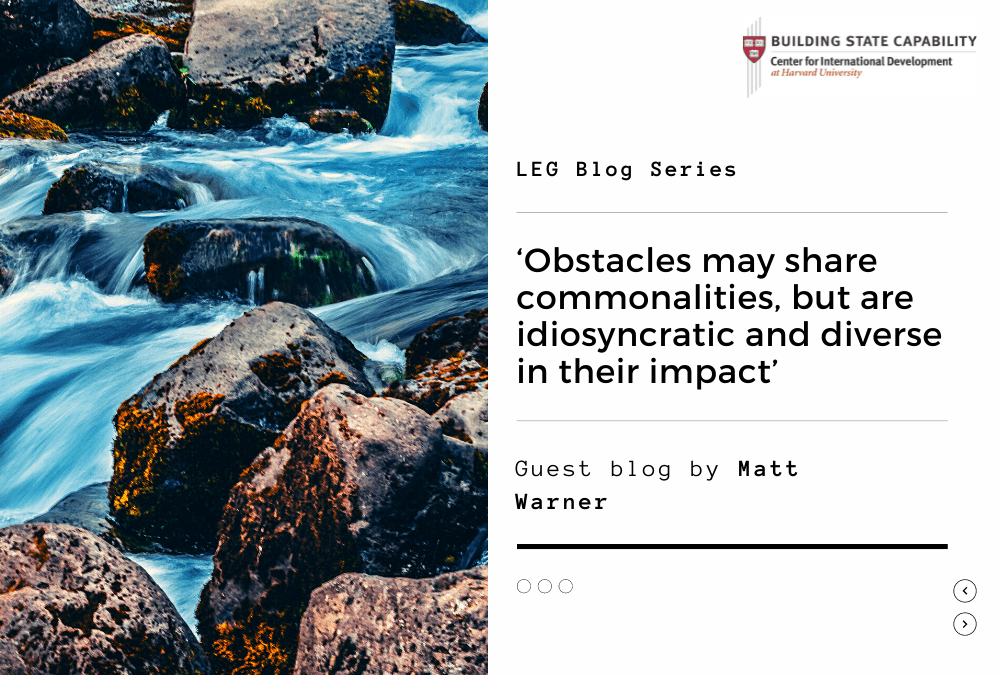Guest blog by Matt Warner
Matt Andrews and Ricardo Hausmann have created one of the most profound educational experiences for those working in development practice focused on inclusive growth. This course has been transformative for my work at an international foundation focused on supporting those aims in multiple developing countries.
Institutions matter, but the big mistake of the last three decades has been operating on the assumption that the “right” institutions could be prescribed ex ante and, with an engineering mentality, delivered like new highways or bridges throughout developing nations, each with their own distinct culture and context.
Instead, enduring institutions emerge and evolve as a function of the dynamic interplay between the people they are meant to govern and the people empowered to represent them. Seen this way, the development practitioner learns to appreciate that the goal of moving from dysfunction to innovative solution is a collaborative, iterative process that requires local knowledge and local participation, building off local know-how as it exists in that particular time and place.
For some, the ambiguity of this approach may fail to satisfy a natural desire for finding and identifying with one, universal solution to the growth challenge. However, reframed as versatility, Andrews and Hausmann better prepare us for the diversity and complexity of the problems we face for which the solutions we seek are more appropriately described as “best fit” rather than “best practice.”
Still, we are not left without practical and proven tools for the journey. PDIA or problem-driven iterative adaption is an inclusive practice that asks institutional representatives in-country to go deep on defining their problems in context and identifying practical options for taking initial action. The process then anticipates learning from those actions and builds in opportunities to revisit assumptions and to pivot accordingly. In this way, entrepreneurial behavior and environmental feedback loops are introduced to the process of institutional change, a better fit for problems of complexity where linear planning is incompatible and inevitably leads to disappointing results.
Growth diagnostics supplement those exercises with rich data and analysis to develop unique hypotheses not just about what matters, but what matters most in a particular context thus empowering practitioners to concentrate their efforts effectively. A stream’s flow may be slowed by many obstacles in the water, but a small branch downstream, once removed, has little effect on dislodging a major logjam further upstream.
To be sure, a stream’s flow is improved, to some degree, with every obstacle removed and I remain convinced that, in the abstract, a stream flows best with no obstacles. What this course helped me see much more clearly, however, is that while many obstacles may share commonalities both within a single stream and across streams in different places, in context they are also idiosyncratic and diverse in their impact. Likewise, and crucially, methods for their removal also tend to require idiosyncratic approaches.
We can continue, as some development traditions do, to try to taxonomize what we hope represents a comprehensive list of all the types of obstacles streams tend to face and then construct a how-to manual on removing them. After this course, however, I am even more convinced that this will only continue to disappoint both because of the limitless complexity of obstacle characteristics in context and, less obviously, similar complexity in the processes needed for their removal.
Tortured metaphors aside, our best hope for inclusive growth is to do the hard work of engaging the process of change in each case and to take great care in prioritizing heavily the collaborative participation and leadership of those for whom the consequences of success and failure will be most directly felt.
This is a blog series written by the alumni of the Leading Economic Growth Executive Education Program at the Harvard Kennedy School. 61 Participants successfully completed this 10-week online course in December 2021. These are their learning journey stories.
